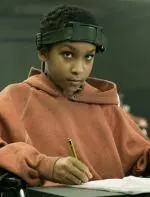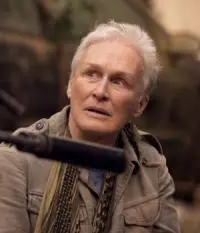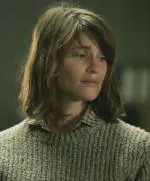The zombie boom of the late oughts and onward—more or less spurred on by the popularity of The Walking Dead TV series—seems to be reaching its nadir, given that tons of people hate The Walking Dead now and audiences in general are thoroughly burnt-out on zombies (just Google "sick of zombie movies" and see what comes up). While it remains to be seen what monster célèbre will next ravage all the books and films, it does seem clear that the flesh-eating undead are shambling out of the public's favor (at least for now).
Which is a shame, because there are a number of tremendous zombie narratives out there, titles that genuinely do something new and exciting with the horror subgenre, including the topic of today's discussion, M.R. (or Mike) Carey's novel The Girl With All The Gifts, and the film of the same name, which Carey also wrote. The book garnered mostly positive reviews upon its publication back in 2014 (from venues such as The Guardian, NPR, Slate, and The A.V. Club) but it seems likely the film adaptation will get swept under the rug of zombie fatigue. Which is a double shame: this is one of the best on-screen depictions of "the walking dead" to come out in quite some time, the exact opposite of that aforementioned AMC show's sluggish meandering, gratuitous violence, and soap opera-style plotting. The Girl With All The Gifts has all the heart of The Walking Dead's first season and a whole lot more to spare, not to mention characters we actually give a shit about.
For those of you curious, though, about how the movie stacks up to its source material, to put the matter simply, they are almost identical in plot and quality, as Carey—in a most nontraditional move—wrote both the novel and screenplay at the same time. There are several subtle differences throughout both narratives, of course, but those have no real bearing on the story overall. Each traverse roughly the same path and end at the same destination. There is, however, a fairly big change from page to screen that alters the tone of the ending, and it's this change we'll focus on here.
The Story
 But before we dive right in, a plot synopsis. If you've read the book or seen the film, feel free to skip ahead to the next section, but if not, you'll need to know the whole narrative to understand the casting conversation we're about to have.
But before we dive right in, a plot synopsis. If you've read the book or seen the film, feel free to skip ahead to the next section, but if not, you'll need to know the whole narrative to understand the casting conversation we're about to have.
So...The Girl With All The Gifts centers on Melanie (brilliantly played by newcomer Sennia Nanua in the film), a young girl and—as we find out more or less right away—a zombie, or, as they're called here, a "hungry." Melanie lives on a military base with a small group of other hungry children. They stay in locked cells at night and attend classes during the day, strapped into chairs by their heads, wrists, and feet. They are a mystery to the adults on the base—namely, Sergeant Parks (Paddy Considine), the hard-nosed leader of the military presence there, Dr. Caldwell (Glenn Close), a rather zealous doctor looking for a cure to the hungry disease (which is effectively the real-life "zombie ant" fungus), and Miss Justineau (Gemma Arterton), one of Melanie's teachers, and the only person who treats the children as human beings. That's the mystery, you see—while Melanie and her peers are hungries, they don't behave like other hungries at all. They retain their consciousness and are able to think, learn, and evolve. Though it is made clear that they are still "monsters" at the end of the day: all personnel on the base wear a special cream all over their bodies that chemically masks their human smell; whenever a hungry child smells their real scent, they go into a trancelike, animal state, in which they snap their jaws and snarl in perfect unison.
Despite these dangers, the primary objective of the base is to assess what it is about these children that allows them to function more or less normally. For Dr. Caldwell, this involves performing vivisections on the children's brains. Miss Justineau knows what goes on in Caldwell's lab, but while's she becomes increasingly vocal about her objections to the project, she mostly allows it to continue. That is, until Melanie is set to go up on Caldwell's slab. Justineau and the protagonist share a special bond, in part because Melanie displays near-genius levels of intelligence. This prompts the teacher to make a stand and barge into Caldwell's lab, threatening the doctor with a fire extinguisher just before the doctor makes her first cut on Melanie. Before this situation can escalate to lethal territory, however, there's a Deus Ex Zombina—a horde of hungries have broke past the base's fence and ransack the place. They burst through the lab windows and swiftly make hungry food out of Caldwell's assistant Dr. Selkirk, allowing Melanie and Justineau to escape. They make a dash through the now chaotic base. Melanie sheds her human "veneer" for the first time and eats two people about to kill her favorite teacher. After which, Parks and one of his soldiers, Gallagher, roll up in a military vehicle and rescues Melanie and Justineau from the melee. As they break through the gate, they realize Caldwell has also hitched a ride with Parks. The group plans to travel to Beacon, another army stronghold, and send a search and rescue team back to their base to gather any survivors. As Melanie is likely Caldwell's last surviving specimen, she plans to continue her work with the smarter-than-average hungry at Beacon, forcing Justineau to stick around and ensure her pupil's safety.
Their journey quickly runs afoul when their vehicle breaks down on the road, forcing the group to travel to Beacon by foot. They run into some hungry trouble—naturally—but manage to bunk down in an old hospital mostly unscathed. Over this night, and under the influence of an authentic bottle of hooch (not the bathtub swill they're used to, a leftover from the old world), Justineau reveals to Parks that before the world went to hell in a hand basket, she'd accidentally struck and killed a child with her car, a crime she never reported due to the burgeoning zombie apocalypse. In the film, this aspect of Justineau's past is only vaguely hinted at, though guilt still drives much of her actions, that being the guilt she feels for having not stopped Caldwell from her experiments earlier—because it is clear that Melanie and all the children they left behind are in fact not merely undead fiends mimicking the behavior of the living; they ARE the living, every bit as alive as Justineau, Parks and Caldwell. This becomes apparent to the audience as well, as we see Melanie become increasingly adept at controlling her hunger, especially if she is allowed to go out and hunt her own food (small animals like cats and foxes, mainly). This shows she actually has a choice, that she can elect not to be a ghoul.
 Despite this progress, Caldwell still has aims at examining Melanie's brain. When the group arrives in London, they make two discoveries that will aid in the doctor's research: one, there are very few walking hungries in the city—most have succumbed so thoroughly to the fungus they are nothing more than the bases for large trees, the trunks of which have sprouted from their chests, and which bear large seeds that, if broken, could cause the hungry disease to become airborne, which would inevitably cause the full-extinction of the human race; two, the group finds an old tank called Rosalind Franklin, a mobile lab sent out into the field years before, which is now abandoned (we infer that the original crew is dead).
Despite this progress, Caldwell still has aims at examining Melanie's brain. When the group arrives in London, they make two discoveries that will aid in the doctor's research: one, there are very few walking hungries in the city—most have succumbed so thoroughly to the fungus they are nothing more than the bases for large trees, the trunks of which have sprouted from their chests, and which bear large seeds that, if broken, could cause the hungry disease to become airborne, which would inevitably cause the full-extinction of the human race; two, the group finds an old tank called Rosalind Franklin, a mobile lab sent out into the field years before, which is now abandoned (we infer that the original crew is dead).
We'll hit fast-forward here: the group takes refuge in Rosalind, and that evening while Melanie hunts for food, she discoveries a community of wild hungry children with her same cognitive abilities, though they haven't evolved quite as intellectually as she has. Their origin—as well as Melanie's—differs between the novel and the film, and they're both somewhat involved, so we'll skip it for now. Just know that it's explained.
Despite Melanie's attempts to keep these children a secret (and thus safe from Caldwell's scalpel) their presence becomes known after they kill and eat Gallagher, Park's right hand man. Melanie then has to save Parks and Justineau from the hungry clan, and she does so by slaying their leader, a baseball bat-wielding boy who paints his face with garish colors to make him resemble a monster. This also causes Melanie to become the clan's leader. Also this coincides with Caldwell's realization that there is, in fact, no cure for Zombitus (or, in the film, that there is a cure, but Caldwell will have to synthesize a part of Melanie's brain to manufacture it). However, in both novel and film, Melanie decides that humanity has had its fair shake at dominating Earth, and now it is time for humanity's second wave—the hungry children—to have a crack at it. She sets fire to the mass of fungal spores in the city, allowing the virus to spread through the air, ensuring all first wavers will succumb to meet their inevitable fate. Caldwell dies (again, it differs how, depending on which version of the narrative you're consuming), Parks gets infected and asks Melanie to mercy kill him before he becomes a Hungry Man, which she does, and Justineau survives, her task in life to continue teaching the hungry children as she taught Melanie, prepping them for their role as the humanity's next wave.
That Aforementioned Big Change
 Okay, if you skipped the synopsis, welcome back. Now, here's the difference between the novel and the film where the denouement is concerned: remember in the novel, Justineau had accidentally murdered a child and never reported it to the police, and this transgression from her past largely informed her "mission" to protect and help Melanie at any cost. When we reach the end of the book, Justineau wears one of Rosalind Franklin's anti-radiation suits and moves around her outdoor classroom, free to touch the children or generally get as close to them as she wants, just as she did at the base, only with far more freedom. Furthermore, just as teaching gave Justineau a sense of joy and purpose on the base, so too does this new classroom give her soul the sustenance it requires.
Okay, if you skipped the synopsis, welcome back. Now, here's the difference between the novel and the film where the denouement is concerned: remember in the novel, Justineau had accidentally murdered a child and never reported it to the police, and this transgression from her past largely informed her "mission" to protect and help Melanie at any cost. When we reach the end of the book, Justineau wears one of Rosalind Franklin's anti-radiation suits and moves around her outdoor classroom, free to touch the children or generally get as close to them as she wants, just as she did at the base, only with far more freedom. Furthermore, just as teaching gave Justineau a sense of joy and purpose on the base, so too does this new classroom give her soul the sustenance it requires.
However, in the film, Justineau remains trapped inside Rosalind Franklin, unable to leave lest she inhale the airborne fungus and turn into a mindless hungry. One of the last shots in the film shows Justineau lying on the floor, looking rather wrung out and shedding a single tear, before Melanie calls the class to order. The star pupil then pastes two photos onto Rosalind Franklin's main window—one of a kitten and one of a bucolic field, the same photos Melanie displayed on her cell wall at the beginning of the narrative, drawing a clear parallel between the hungry child's former captivity and her teacher's current imprisonment, even if Justineau could technically walk out anytime she wanted (sacrificing her consciousness in the process). It's a more somber and altogether darker ending than the more hopeful ending Carey crafted for his novel.
Which raises the question: does one ending work better than the other? Given that the narratives up until the denouement are virtually the same, does this slightly darker denouement detract from everything that preceded it?
 I think in this case, it's an even tie, Unlike with Fight Club, in which the film's ending actually topped the novel's, both versions of The Girl With All The Gifts satisfy at narrative end. One ending does not outshine the other, when you get right down to it.
I think in this case, it's an even tie, Unlike with Fight Club, in which the film's ending actually topped the novel's, both versions of The Girl With All The Gifts satisfy at narrative end. One ending does not outshine the other, when you get right down to it.
One Final Question
It would seem that there really isn't a reason to read the book over seeing the novel, or vice versa, given their similarities, but the main advantage of the novel is, as is usually the case, further character development, which arises mainly from Carey's technique of switching between the POVs of the novel's main players. But beyond this, the novel gets more in depth with the science behind the fungal infection, and it all sounds alarmingly plausible. So if you'd prefer a lot more scientific and psychological exploration, pick up the book, but if you're mainly interested in the story, watch the film—though as always, I would strongly encourage you to experience both, as they are both time well spent. Just like the hungry children who set out to replace humanity as we know it, it is my hope that more narratives like The Girl With All The Gifts emerge in the future, to wipe out the stagnation of the zombie subgenre and replace it with the smart, sociologically perceptive horror narratives we all came to love—narratives that innovate rather than regurgitate, thrill rather than bore.
Have you read The Girl With All The Gifts? Seen the movie? Both? What did you think about the differences between the two, especially the more maudlin ending of the film? Let us know your thoughts in the comments section below.

About the author
Christopher Shultz writes plays and fiction. His works have appeared at The Inkwell Theatre's Playwrights' Night, and in Pseudopod, Unnerving Magazine, Apex Magazine, freeze frame flash fiction and Grievous Angel, among other places. He has also contributed columns on books and film at LitReactor, The Cinematropolis, and Tor.com. Christopher currently lives in Oklahoma City. More info at christophershultz.com







